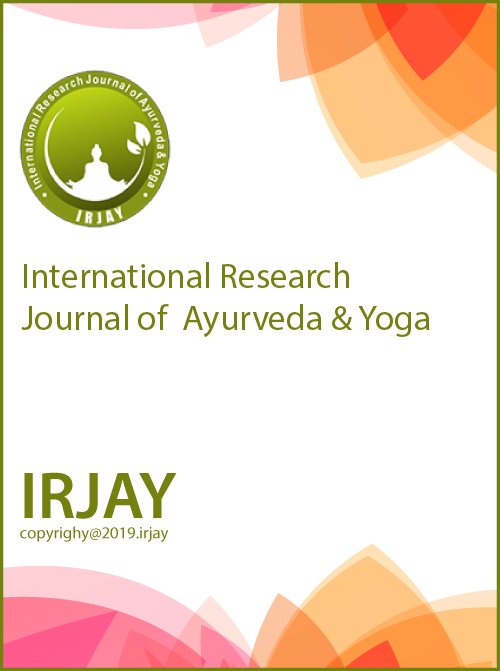Alleviating Shoulder Pain and Enhancing Scapular Joint Range of Motion in Avabahuka (Frozen Shoulder) through Marma Chikitsa: A Case Study
DOI:
https://doi.org/10.48165/IRJAY.2025.80408Keywords:
Frozen shoulder, Marma Chikitsa, Ayurveda, shoulder pain, AvabahukaAbstract
Frozen shoulder, medically termed adhesive capsulitis, is a debilitating condition that restricts shoulder mobility and causes pain. This ailment is frequently linked to medical conditions such as diabetes and hypothyroidism. This case study explored Marma Chikitsa, an Ayurvedic treatment, as an alternative to conventional pharmacological and physiotherapy interventions. A 31-year-old male with persistent right shoulder pain and rigidity who was unresponsive to NSAIDs and physiotherapy underwent treatment with Marma Chikitsa. Therapy involved applying pressure and gently stimulating specific Marma points on the shoulder twice daily. Pain assessment done by using the NRS-11 scale and goniometric measurements of shoulder function were performed. After treatment, the patient’s pain decreased from 7 to 1 on the NRS-11 scale, with significant improvements in shoulder movement: abduction increased from 60° to > 160°, flexion from 70° to >160°, and extension from 30° to 60°. Marma Chikitsa may improve energy and blood circulation, promote muscle relaxation, and reduce pain in frozen shoulder patients. This non-invasive, integrative approach offers a safe, effective, and affordable alternative to traditional interventions, showing promise as a potential treatment and management method for frozen shoulder. Adhesive capsulitis, commonly referred to as frozen shoulder, is a disabling condition marked by shoulder joint stiffness and discomfort, resulting in limited range of motion (ROM).[1] This condition, referred to as “Avabahuka” in Ayurvedic medicine, significantly affects an individual’s quality of life and daily activities.[2] While conventional treatments such as physical therapy, corticosteroid injections, and, in severe cases, surgical interventions are commonly employed,[3,4] there is growing interest in alternative approaches, particularly those rooted in traditional medical systems.[5]
Downloads
References
1. Kakad Y, Akhade BS. Management of avabahuka (frozen shoulder)- a case study. J Res Med Dent Sci. 2022;10:158-61. doi: 10.5005/jras 10064-0100
2. De la Serna D, Navarro-Ledesma S, Alayón F, López E, Pruimboom L. A comprehensive view of frozen shoulder: A mystery syndrome. Front Med (Lausanne). 2021;8:663703. doi: 10.3389/ fmed.2021.663703
3. Itoi E, Arce G, Bain GI, Diercks RL, Guttmann D, Imhoff AB, et al. Shoulder stiffness: current concepts and concerns. Arthroscopy. 2016;32:1402-14. doi: 10.1016/j.arthro.2016.03.024
4. Cohen C, Ejnisman B. Epidemiology of frozen shoulder. In: Shoulder Stiffness. Berlin: Springer. p. 20152130. doi: 10.1007/978-3-662- 46370-3_2
5. Wong CK, Levine WN, Deo K, Kesting RS, Mercer EA, Schram GA, et al. Natural history of frozen shoulder: Fact or fiction? A systematic review. Physiotherapy. 2017;103:40-7. doi: 10.1016/j. physio.2016.05.009
6. Phansopkar P, Qureshi M. A review on current notion in frozen shoulder: A mystery shoulder. Cureus. 2022;14:29362. doi: 10.7759/ cureus.29362
7. Uppal HS, Evans JP, Smith C. Frozen shoulder: A systematic review of therapeutic options. World J Orthop. 2015;6:263-8. doi: 10.5312/ wjo.v6.i2.263
8. Hsu JE, Anakwenze OA, Warrender WJ, Abboud JA. Current review of adhesive capsulitis. J Shoulder Elbow Surg. 2011;20:502-14. doi: 10.1016/j.jse.2010.08.023
9. Kelley MJ, McClure PW, Leggin BG. Frozen shoulder: Evidence and a proposed model guiding rehabilitation. J Orthop Sports Phys Ther. 2009;39:135-48. doi: 10.2519/jospt.2009.2916
10. Chan JH, Ho BS, Alvi HM, Saltzman MD, Marra G. The relationship between the incidence of adhesive capsulitis and hemoglobin A1c. J Shoulder Elbow Surg. 2017;26:1834-7. doi: 10.1016/j.jse.2017.03.015
11. Sharma PV, editor. Sushruta Samhita of Sushruta, Nidana Sthana. 2nd ed. Varanasi: Chaukhamba Orientalia. 1991. p. 17.
12. Upadhyay Y, editor. Madhava Nidana of Madhavkara, Nidan Sthana. Varanasi: Chaukhamba Surabharati Prakashan; 1986.


